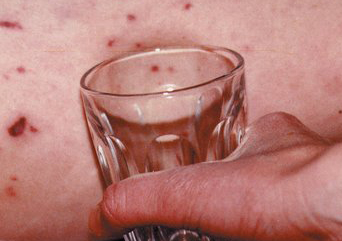Fever in children over 5 years
Advice for parents and carers of children 5 years and older
If your child has any of the following:
- Becomes pale, mottled and feels abnormally cold to touch
- Is going blue around the lips
- Severe breathing difficulty - too breathless to talk / eat or drink
- Has a fit / seizure
- Becomes extremely agitated, confused or very lethargic (difficult to wake)
- Develops a rash that does not disappear with pressure (see the ‘Glass Test’ overleaf)
You need urgent help
Go to the nearest Hospital Emergency (A&E) Department or phone 999
If your child has any of the following:
- Is finding it hard to breath
- Seems dehydrated (sunken eyes, drowsy or no urine passed for 12 hours)
- Is becoming drowsy (excessively sleepy) or irritable (unable to settle them with toys, TV, food or picking up) – especially if they remain drowsy or irritable despite their fever coming down
- Has extreme shivering or complains of muscle pain
- Continues to have a fever of 38.0°C or above for more than 5 days
- Is getting worse or if you are worried
You need to contact a doctor or nurse today
Please ring your GP surgery or contact NHS 111 - dial 111 or for children aged 5 years and above visit 111.nhs.uk
- If none of the above features are present
Self Care
Using the advice below you can provide the care your child needs at home
- Keep your child as comfortable as possible. Consider giving paracetamol or ibuprofen for comfort.
- Offer them simple food and regular drinks.
- If they are vomiting, offer small frequent drinks as this is more likely to stay down.
- Do not try to control your child’s temperature with tepid sponging or fans.
- Keep an eye on your child day and night and follow the guidance overleaf. If a rash appears do “the glass test” (see guidance overleaf).
- If your child is due their vaccinations, postpone until after their fever has improved.
- Notify their school if you need to keep your child away while they are unwell and have a fever – see www.what0-18.nhs.uk for advice if you are unsure whether they need to be kept off school or not.
Most children with a fever do get better very quickly but some children can get worse. You need to regularly check your child during the day and also through the night and follow the advice given below.
- Fever is extremely common in children and usually suggests that your child has an infection.
- Your child has a fever if their temperature is over 38°C. The most accurate way of measuring your child’s temperature is with a digital thermometer.
- Viral infections are far more common than bacterial infections. Symptoms such as runny nose, cough, wheeze, sore throat, red eyes and diarrhoea are more suggestive of a viral infection than a bacterial infection. If a number of people are unwell in the same household, this also suggests a viral infection.
- Viral infections tend to get better on their own and do not need treatment with antibiotics.
- If your child is distressed you should consider giving them paracetamol or ibuprofen to help them feel more comfortable. Use one and if your child has not improved 2-3 hours later you may want to try giving the other medicine.
- Carefully read the instructions on the medicine for dose and frequency.
- You could ask your local pharmacist for more advice about medicines.
- In general, we do not recommend cough medicines.

The Glass Test
Do the ‘glass test’ if your child has a rash. Press a glass tumbler firmly against the rash. If you can see the spots through the glass and they do not fade as you press the glass onto the skin then this is called a ‘non-blanching rash’. If you see this type of rash, seek medical advice immediately. The rash is harder to see on dark skin so check paler areas, such as palms of the hands, soles of the feet and tummy.
(Photo courtesy of the Meningitis Research Foundation 2013)

